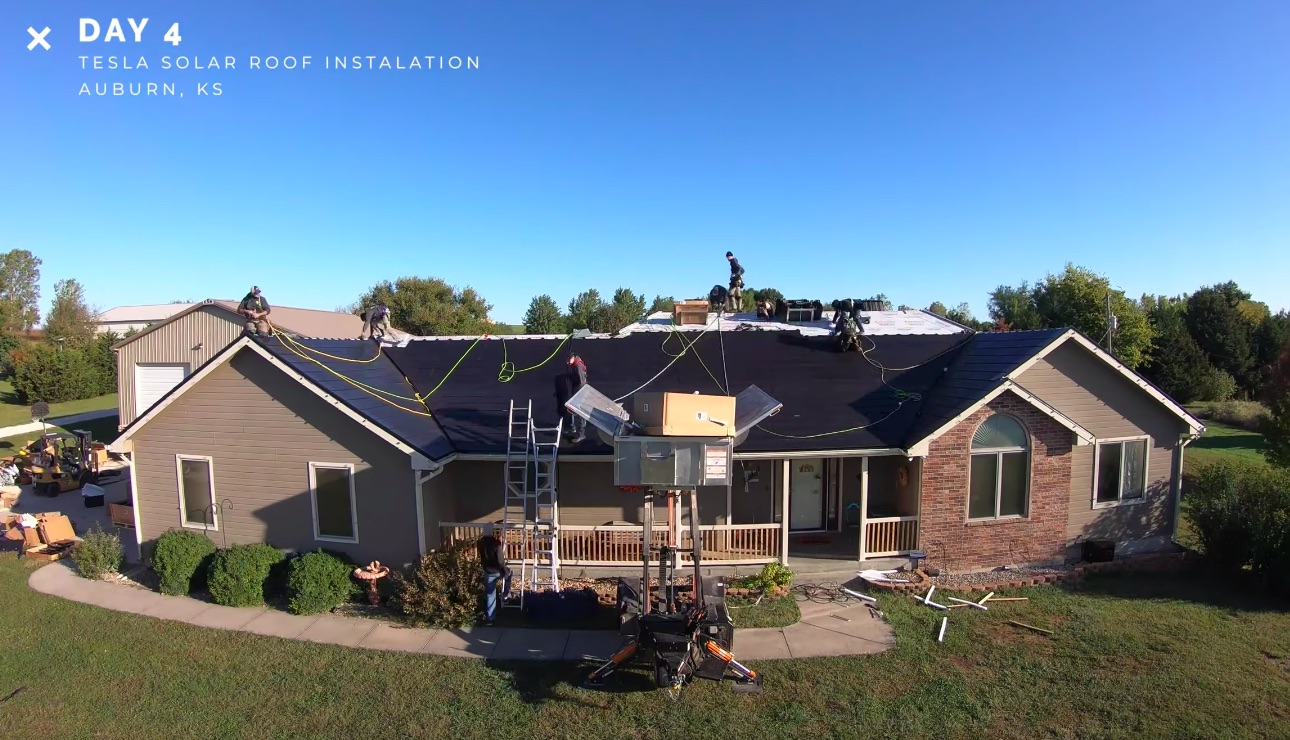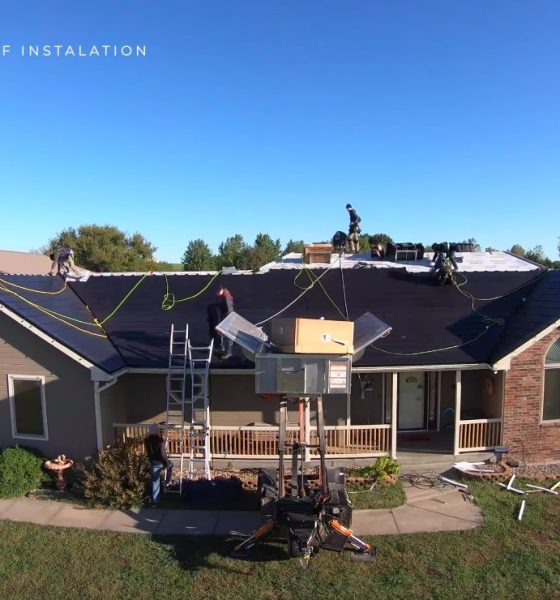

News
Tesla Solar Roof is becoming a stealthy killer, and no one is standing in its way
Tesla executives like CEO Elon Musk may emphasize that the company’s Energy business is just as important as its electric vehicle division, there is little doubt that stationary batteries and solar products are just not as sexy or exciting as, say, all-electric supercars, futuristic pickups, or Full Self-Driving software. Yet as Tesla Energy hits its stride, it is becoming evident that some of the company’s products like the Solar Roof could very well develop into stealthy disruptors on their own.
Tesla Energy’s flagship solar product is the Solar Roof, which was initially unveiled in 2016. Since then, the attractive solar shingles have not really seen a serious ramp, at least until now. Over the following years since its debut, Tesla focused on optimizing and improving the Solar Roof, and the result of these initiatives was the V3 tiles, which were rolled out last year. Tesla’s Solar Roof installations have been steadily ramping then, but just like the company’s energy division, its growth was mostly in the background.
Prior to the third-quarter earnings call, Tesla Energy made headlines after roofing company Weddle and Sons Roofing announced that it was able to complete a full Solar Roof installation in just four days. The project was no joke either, as the system was comprised of 15 kW of Solar Roof tiles that covered about 4,000 sq.ft. (about 372 sq.m). This was a milestone for the company, but as noted by Tesla in its Q3 2020 Update Letter, this installation was not even the fastest to date.
Tesla revealed in its third-quarter Update Letter that it has been able to complete a full Solar Roof installation in just 1.5 days. The company did not indicate the size of the system, though it did provide images depicting the installation’s progress. This update, together with the recent report from Weddle and Sons Roofing, shows that steadily, Tesla’s Solar Roof tiles are becoming faster and easier to install.
Tesla Energy’s growth in the third quarter was incredibly impressive, with the company deploying 57 MW of solar, a 111% growth from the second quarter. The company also announced that 759 MWh worth of battery storage was deployed, an 81% increase from Q2 2020. These milestones tend to be pushed aside by the company’s FSD and EV developments, but if Tesla Energy continues at this pace, it would only be a matter of time before the company’s solar and battery storage systems end up becoming a force that will be incredibly difficult to ignore.
Interestingly enough, the Tesla Solar Roof does not really have a lot of competition in the residential solar market in the United States. Granted, products like the SunTegra Solar Shingles could provide some competition, but the overall lineup of rivals for the electric car maker’s V3 tiles are relatively few. With this in mind, the potential path to dominance for the Tesla Solar Roof seems to be mostly clear. Tesla just has to produce them at volumes that meet demand.
Tesla’s reach into the residential market has actually been growing. EnergySage’s eleventh semiannual Solar Marketplace Intel Report, for one, concluded that the Tesla Powerwall 2 is pretty much dominating the US residential market for stationary storage. The competition, comprised of battery storage units from companies like LG Chem, lie far behind, with the Powerwall dominating about half of the quotes given in EnergySage’s Marketplace.
Elon Musk spoke about the Solar Roof’s potential in Tesla’s recently-held earnings call. Just like before, Musk was optimistic about the shingles, though this time around, the CEO seemed to be more certain about its upcoming disruption. Musk even remarked that the Solar Roof’s status as a “killer product” will become evident next year.
“When you look around the neighborhood in the future, decade from now, what do you want? What products are going to make your life better? What future do you want? And I think a future where we’ve got beautiful roofs generating energy that are tough and resilient and better in every way than a regular roof and alive with energy, that’s the future we want. Solar Roof is a killer product. This will become obvious next year,” he said.

Elon Musk
Elon Musk and Tesla AI Director share insights after empty driver seat Robotaxi rides
The executives’ unoccupied tests hint at the rapid progress of Tesla’s unsupervised Robotaxi efforts.

Tesla CEO Elon Musk and AI Director Ashok Elluswamy celebrated Christmas Eve by sharing personal experiences with Robotaxi vehicles that had no safety monitor or occupant in the driver’s seat. Musk described the system’s “perfect driving” around Austin, while Elluswamy posted video from the back seat, calling it “an amazing experience.”
The executives’ unoccupied tests hint at the rapid progress of Tesla’s unsupervised Robotaxi efforts.
Elon and Ashok’s firsthand Robotaxi insights
Prior to Musk and the Tesla AI Director’s posts, sightings of unmanned Teslas navigating public roads were widely shared on social media. One such vehicle was spotted in Austin, Texas, which Elon Musk acknowleged by stating that “Testing is underway with no occupants in the car.”
Based on his Christmas Eve post, Musk seemed to have tested an unmanned Tesla himself. “A Tesla with no safety monitor in the car and me sitting in the passenger seat took me all around Austin on Sunday with perfect driving,” Musk wrote in his post.
Elluswamy responded with a 2-minute video showing himself in the rear of an unmanned Tesla. The video featured the vehicle’s empty front seats, as well as its smooth handling through real-world traffic. He captioned his video with the words, “It’s an amazing experience!”
Towards Unsupervised operations
During an xAI Hackathon earlier this month, Elon Musk mentioned that Tesla owed be removing Safety Monitors from its Robotaxis in Austin in just three weeks. “Unsupervised is pretty much solved at this point. So there will be Tesla Robotaxis operating in Austin with no one in them. Not even anyone in the passenger seat in about three weeks,” he said. Musk echoed similar estimates at the 2025 Annual Shareholder Meeting and the Q3 2025 earnings call.
Considering the insights that were posted Musk and Elluswamy, it does appear that Tesla is working hard towards operating its Robotaxis with no safety monitors. This is quite impressive considering that the service was launched just earlier this year.
Elon Musk
Starlink passes 9 million active customers just weeks after hitting 8 million
The milestone highlights the accelerating growth of Starlink, which has now been adding over 20,000 new users per day.

SpaceX’s Starlink satellite internet service has continued its rapid global expansion, surpassing 9 million active customers just weeks after crossing the 8 million mark.
The milestone highlights the accelerating growth of Starlink, which has now been adding over 20,000 new users per day.
9 million customers
In a post on X, SpaceX stated that Starlink now serves over 9 million active users across 155 countries, territories, and markets. The company reached 8 million customers in early November, meaning it added roughly 1 million subscribers in under seven weeks, or about 21,275 new users on average per day.
“Starlink is connecting more than 9M active customers with high-speed internet across 155 countries, territories, and many other markets,” Starlink wrote in a post on its official X account. SpaceX President Gwynne Shotwell also celebrated the milestone on X. “A huge thank you to all of our customers and congrats to the Starlink team for such an incredible product,” she wrote.
That growth rate reflects both rising demand for broadband in underserved regions and Starlink’s expanding satellite constellation, which now includes more than 9,000 low-Earth-orbit satellites designed to deliver high-speed, low-latency internet worldwide.
Starlink’s momentum
Starlink’s momentum has been building up. SpaceX reported 4.6 million Starlink customers in December 2024, followed by 7 million by August 2025, and 8 million customers in November. Independent data also suggests Starlink usage is rising sharply, with Cloudflare reporting that global web traffic from Starlink users more than doubled in 2025, as noted in an Insider report.
Starlink’s momentum is increasingly tied to SpaceX’s broader financial outlook. Elon Musk has said the satellite network is “by far” the company’s largest revenue driver, and reports suggest SpaceX may be positioning itself for an initial public offering as soon as next year, with valuations estimated as high as $1.5 trillion. Musk has also suggested in the past that Starlink could have its own IPO in the future.
News
NVIDIA Director of Robotics: Tesla FSD v14 is the first AI to pass the “Physical Turing Test”
After testing FSD v14, Fan stated that his experience with FSD felt magical at first, but it soon started to feel like a routine.

NVIDIA Director of Robotics Jim Fan has praised Tesla’s Full Self-Driving (Supervised) v14 as the first AI to pass what he described as a “Physical Turing Test.”
After testing FSD v14, Fan stated that his experience with FSD felt magical at first, but it soon started to feel like a routine. And just like smartphones today, removing it now would “actively hurt.”
Jim Fan’s hands-on FSD v14 impressions
Fan, a leading researcher in embodied AI who is currently solving Physical AI at NVIDIA and spearheading the company’s Project GR00T initiative, noted that he actually was late to the Tesla game. He was, however, one of the first to try out FSD v14.
“I was very late to own a Tesla but among the earliest to try out FSD v14. It’s perhaps the first time I experience an AI that passes the Physical Turing Test: after a long day at work, you press a button, lay back, and couldn’t tell if a neural net or a human drove you home,” Fan wrote in a post on X.
Fan added: “Despite knowing exactly how robot learning works, I still find it magical watching the steering wheel turn by itself. First it feels surreal, next it becomes routine. Then, like the smartphone, taking it away actively hurts. This is how humanity gets rewired and glued to god-like technologies.”
The Physical Turing Test
The original Turing Test was conceived by Alan Turing in 1950, and it was aimed at determining if a machine could exhibit behavior that is equivalent to or indistinguishable from a human. By focusing on text-based conversations, the original Turing Test set a high bar for natural language processing and machine learning.
This test has been passed by today’s large language models. However, the capability to converse in a humanlike manner is a completely different challenge from performing real-world problem-solving or physical interactions. Thus, Fan introduced the Physical Turing Test, which challenges AI systems to demonstrate intelligence through physical actions.
Based on Fan’s comments, Tesla has demonstrated these intelligent physical actions with FSD v14. Elon Musk agreed with the NVIDIA executive, stating in a post on X that with FSD v14, “you can sense the sentience maturing.” Musk also praised Tesla AI, calling it the best “real-world AI” today.








